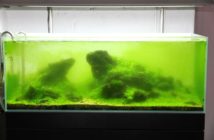About two weeks ago, I wrote the Sandbeds in Aquariums. In it I commented on barebottom aquariums, and this is the follow-up to that mention.
For years, sand has played a major role in saltwater aquariums. Sand is beneficial in so many ways, especially aragonite-based sand. In a nutshell, sand provides calcium, alkalinity, and pH buffering, as well as a home and food source for all sorts of fish and invertebrates. But most importantly of all, sand provided the surface area for a majority of the nitrifying bacteria that processes the waste material given off by our livestock. A last benefit is a purely asthetic one. Many aquarists simply like the look of a sandbed.
But if sand is so important for the saltwater aquarium, why are barebottom (sandless) aquariums becoming a popular trend? To answer this, we must look at who the primary users of a barebottom aquarium are…and this is mostly the hard coral enthusiasts. These hard corals, focusing mainly on SPS corals in the Acropora and Montipora genus, require quite a bit of flow and need a low nutrient environment in order to thrive. As you can imagine, sand poses somewhat of a problem for high flow setups, especially if it is of a finer grain size. The water movement can create sand storms and bury low lying corals, which will kill them eventually. If you have no sand in the aquarium, then you can have pretty much any amount of gallons per hour flowing through your aquarium.
An immediate benefit to higher flow is that it will help keep detritus, or waste, suspsended in the water column for removal via aquarium filters and protein skimmers. Sand is really good at trapping this detritus, thereby causing a constant supply of detrimental nutrients and less than perfect water quality. In a barebottom setup, you can easily see all the detritus so that it can easily be removed via siphoning. Additionally, more flow can deliver more of the required elements (calcium for example) to the corals at a faster rate, while at the same time removing metabolic waste from the coral. This leads to increased growth rates and overall healthier livestock.
Barebottom setups, to some, don’t look as good to some people, and are certainly not as natural looking. But some barebottom users place a “Starboard” material on the bottom of the aquarium, which protects the glass and somewhat looks like a faux sandbed. To further sell the look, some have glued sand grains to the material itself. Or if you want to be creative, you can grow corals directly onto the Starboard. One great example is green star polyps, or zoanthids, which grow in mattes onto virtually any surface.
I personally have mixed feelings about the barebottom setup. I, like most, have used sandbeds for years, but since my setup mostly consists of hard corals, I am very attracted to removing all of my sand. I have started the process of sand removal, but I must warn those who want to make the switch…your rockwork will shift and you should not remove more than a few pounds of sand per week so that you do not alter the bacteria/nutrient equilibrium which may result in algae blooms or even livestock loss.





